Ballygarvan House
Houses within 10km of this house
Displaying 88 houses.
Houses within 10km of Ballygarvan House
Displaying 88 houses.
| House name | Description | |
|---|---|---|
| Vernon Mount | Built by Atwell Hayes in the 1780s, Vernon Mount was the residence of John Leslie in 1814 and of O. Hayes in 1837. Soon afterwards it was leased to William Lane and he was the occupier at the time of Griffith's Valuation, holding the house valued at £55 from Attiwell Hayes. The Hayes sale rental of 1851 describes this house as "a large handsome building erected by the present owner's father at a cost of £5000". It was leased by the Hayes family to William Lane in 1839. A building still exists at this site. | |
| Ballinaboy House | In 1837 Lewis describes this house as a "handsome modern mansion surrounded with young and thriving plantations". John Moloney held Ballinaboy House in fee at the time of Griffith's Valuation, when it was valued at £40. Lewis described it as "a handsome modern mansion, the seat of J. Moloney" in 1837. In the early 1940s the Irish Tourist Association survey described it as being "in a good state of preservation" and occupied by a Mr.Tuttle. It is still extant and occupied. |

|
| Sheep Glen | John H. Wheatley was leasing this property to Michael Roberts at the time of Griffith's Valuation, when it was valued at £7 10s. It is still extant and occupied, situated on a large farm. | |
| Ballinluig | Isaac Seymour was leasing this property to John Smith at the time of Griffith's Valuation, when it was valued at almost £9. This house is no longer extant. | |
| Arlinstown House | James Gillman was leasing Arlinstown House to Thomas Richardson Leane at the time of Griffith's Valuation, when it was valued at £15. A house and extensive farm buildings are extant at this site now. | |
| Ballindresrough Mills | William R. Meade was leasing this property to Daniel Keller at the time of Griffith's Valuation, when it was valued at £25, including a flour mills. It is not marked on the later 25-inch map, suggesting it was no longer operational in the 1890s. Extensive farm buildings occupy the site now. | |
| Ballintober House | Sir John Meade, Knight, was located at Ballintober at the beginning of the 18th century. In 1777 and 1786 it was the seat of Reverend Mr. Meade. Ballintober House was held in fee by Reverend John Meade at the time of Griffith's Valuation, when it was valued at £30. Lewis refers to it as the seat of J. Meade in 1837. In the 1870s it was the property of Reverend Mr. Meade. In the 1940s the Irish Tourist Association Survey stated that it was the property of John Meade whose family had held it since the reign of Elizabeth I. The National Inventory of Architectural Heritage indicates that the original house is now ruinous but there are later buildings at the site. |

|
| Ballymartle | William R. Meade held Ballymartle in fee at the time of Griffith's Valuation, when it was valued at £35. It was also noted by Lewis as the seat of W.R. Meade in 1837. In the 1770s it was the property of Rev. W, Meade. In the 1940s the Irish Tourist Association Survey described it as "an imposing residence in a finely wooded estate, occupied by Major Meade". It is now a roofless ruin. |

|
| Mill-Land | William Meade was leasing this property to Thomas R. Leane at the time of Griffith's Valuation, when it was valued at almost £9. | |
| Mullagh or Rock Hill House | William R. Meade was leasing this property to Thomas R. Leane at the time of Griffith's Valuation, when it was valued at £8 10s. It is labelled as Rock Hill House on the 6-inch Ordnance Survey map but appears on the 25-inch map of the 1890s as Mullagh House. A possibly later house and large farm occupy the site now. | |
| Coolkirky | The representatives of Gresham Herrick held this property in fee at the time of Griffith's Valuation, when it was valued at £25. The house burned down in the late 1990s. | |
| Glendoneen | Jeremiah Roberts was leasing this property to Rev. John Stoytt at the time of Griffith's Valuation, when it was valued at £45. Lewis refers to Glendoneen as the seat of Rev. J. Stoyte in 1837. It is still extant and occupied. |

|
| Stonehill House | Henry Busteed was leasing Stonehill House from William B. Warren and others at the time of Griffith's Valuation, when it was valued at £11 10s. A smaller house in the same townland, also owned by Warren and known as Maryville [W725608], was valued at £8. It was occupied by Robert Condron at that time. Neither of these houses are extant now. | |
| Glinny House | George Dunne was leasing Glinny House from Thomas Daunt at the time of Griffith's Valuation, when it was valued at £25. Lewis refers to it as the seat of G.N. Dunne in 1837. The Daunt family also owned Glinny Cottage [W669595] in the same townland, then valued at £8 and occupied by Elizabeth Walsh. Though altered Glinny House is still extant. |
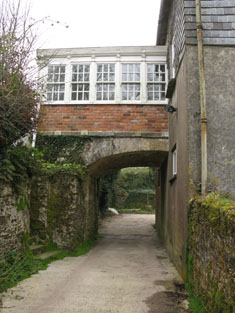
|
| Heathburn Hall | George Daunt held this property in fee at the time of Griffith's Valuation, when it was valued at £35. The National Inventory of Architectural Heritage notes that it was later associated with the Shaw familiy who made additions to the house in the early twentieth century. In the 1940s the Irish Tourist Association Survey noted it a the residence of Mr. Bateman. There is still an extant property at the site. | |
| Rigsdale House | Not named on the 1st edition Ordnance Survey map but labelled Rigsdale House on the 25-inch map, published in 1899. At the time of Griffith's Valuation it was described as "herd's house" and being leased by the Wheatley estate to the representatives of Benjamin Roberts. It was valued at £10 at the time. In the early 1940s the Irish Tourist Association survey noted that " there is no trace of the old residence of the family. Richard Bird lives in modern residence of Rigsdale". It is still extant and part of a farming enterprise. |

|
| Ballindeenisk House | Mrs. Charlotte Harrison held this property in fee at the time of Griffith's Valuation, when it was valued at £8. It is one of two houses labelled Ballindeenisk House on the 1st edition Ordnance Survey map and it also appears under this name on the later 25-inch edition of the 1890s. It is no longer extant. | |
| Cramer's Court or Ballindeenisk | Labelled as Ballindeenisk on the 1st edition Ordnance Map and as Cramer's Court on the 25-inch series published in the 1890s. It was being leased by Benjamin Jeffers from the Earl of Bandon's estate at the time of Griffith's Valuation, when it was valued at £11. It is now a Nursing Home. |

|
| Broomley | George Daunt was leasing Broomley from Reverend Thomas Townsend at the time of Griffith's Valuation, when it was valued at £18. Lewis refers to it as his seat in 1837. In 1942 the Irish Tourist Association Survey also noted it as a residence of the Daunt family. It is now a ruin. | |
| Willowhill House | Edward R. Warren was leasing Willow Hill House to Thomas Hungerford at the time of Griffith's Valuation, when it was valued at £13. It is still extant and occupied. |
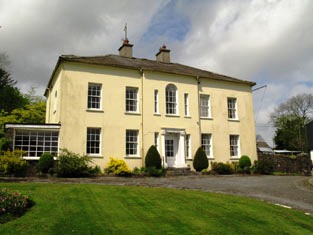
|
| Old Castle (Tracton) | Achilles Daunt was leasing this property to Bartholomew Coveney at the time of Griffith's Valuation, when it was valued at £10. A house and extensive farm now exist at the site. | |
| Tracton Cottage | Achilles Daunt was leasing this property to Richard Hungerford at the time of Griffith's Valuation, when it was valued at £7. A house still exists at the site. | |
| Tracton Abbey | Denis Coveney was leasing this property from Achilles Daunt at the time of Griffith's Valuation, when it was valued at almost £9 with an adjacent mill valued at £11. Buildings are still extant at the site. | |
| Fivemilebridge Mill House | Joseph Coghlan was leasing this property to William Herrick at the time of Griffith's Valuation, when it and the adjacent mill were valued at £53. The mill buildings are no longer visible on the 25-inch map of the 1890s. The house is still extant. |
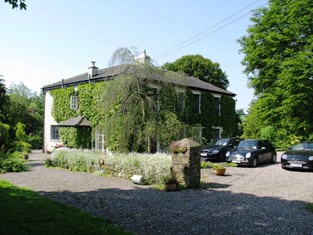
|
| Myrtle Hill | Richard Barter was leasing this house to Denis Ahern at the time of Griffith's Valuation, when it was valued at £12. Myrtlehill Farm is still extant at the site. | |
| Fahalea | Thomas Daunt held this property in fee at the time of Griffith's Valuation, when it was valued at £10. Extensive farm buildings exist at the site now. | |
| Ballynametagh | At the time of Griffith's Valuation, John Kingston was leasing this house to Daniel Coates, when it was valued at £9. A modern house and farm occupy this site now. | |
| Waterpark | This was a Lavallin home in the 18th century. Robert Atkins leased this property from the representatives of Thomas Dorman/Dormand at the time of Griffith's Valuation. It was valued at £48. | |
| Mount Rivers (Carrigaline) | Michael Roberts was leasing Mount Rivers from the representatives of Daniel Morrison at the time of Griffith's Valuation, when it was valued at £45+. The sale rental of 1863 records Michael Hodder Joseph Roberts as the tenant of Mount Rivers. The house is still extent and the National Inventory of Architectural Heritage states that it is still owned by the Roberts family. |

|
| Ravenswood or Monroe House | Michael Roberts was leasing this property to Ralph Westropp at the time of Griffith's Valuation, when it was valued at £38. On the 1st edition Ordnance Survey map it is labelled Monroe House but later came to be known as Ravenswood House. Monroe House appears at a different location (W715627) on the 25-inch Ordnance Survey Map of the 1890s. Ravenswood was occupied by the Westropp family until the twentieth century. |

|
| Beaver Lodge & Carrigaline Mill | Michael Roberts was leasing this property from Michael O'Brien at the time of Griffith's Valuation. It included a mill and was valued at £100. Buildings at this site appear to have been demolished in the first decade of this century. | |
| Carrigaline West | At the time of Griffith's Valuation, Rev. Charles McCormack was leasing this property from Michael Roberts when it was valued at £10. This may be the property which afterwards became known as Monroe House. Later in the century, Carrigaline Rectory was located in the townland of Carrigaline Middle (W730630) | |
| Commeen | Thomas Hayes was leasing this property to Richard Hayes at the time of Griffith's Valuation, when it was valued at £8, on a holding of 230 acres. On the 25-inch Ordnance Survey map of the 1890s it is labelled Commeen Kennels. Farm buildings still exist at the site. | |
| Coolmore | Held in fee by Reverend Edward H. Newenham at the time of Griffith's Valuation, when it was valued at £100. He was leasing a smaller house, valued at £8, to John Donegan in the same townland. Noted by Leet as the residence of W.W. Newenham in 1814. Valued at £64 in 1906 when it was the residence of Major William W. Newenham. The Irish Tourist Association Survey also noted it as belonging to the Newenhams in 1943. It is still extant but in poor repair. |
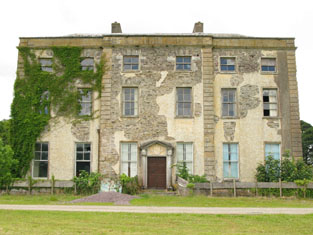
|
| Shanbally Cottage (Carrigaline) | Thomas Burke was leasing this property to Joseph Beaumont at the time of Griffith's Valuation. It was valued at £34 and included a mill. The latter, known as Rathanallig Mills (W751651), is described as "in ruins" on the 25-inch Ordnance Survey Map of the 1890s while the house is diminished in size and has since disappeared. There are still buildings on the mill site. | |
| Killanully | Rev. Edward Newenham was leasing this property to Michael Donegan at the time of Griffith's Valuation, when it was valued at £9. | |
| Kilmoney Abbey | At the time of Griffith's Valuation, Michael Roberts was leasing this property from Thomas R. Sarsfield, when it was valued at £50. Lewis referred to it as the "handsome residence" of Michael Roberts in 1837. It is stil extant and well maintained. Thomas Sarsfield was leasing a smaller propertyin the same townland, valued at £9, to Eugene McCarthy. There are two properties shown on the 25-inch Ordnance Survey map of the 1890s, Kilmoney House and Kilmoney Cottage. Buildings are still extant at these sites though extensive urban development has occurred in the area. |

|
| Ballea Castle | Francis Hodder held this property in fee at the time of Griffith's Valuation, when it was valued at £24 10s. Lewis also refers to it as his seat in 1837. Local sources suggest that It was originally built by the McCarthy family and later acquired by the Hodders. In the 1940s the Irish Tourist Association survey refers to it as being occupied by F. Dorman, retired engineer, and that it was the oldest occupied castle in Éire. Though much altered over the years, it is still extant and occupied. |

|
| Ballea Mill | Thomas Hewitt was leasing this property to Thomas Sullivan at the time of Griffith's Valuation, when it was valued at £20, including the adjacent mill. The latter property is labelled "in ruins" on the 25-inch Ordnance Survey map of the 1890s. | |
| Ballea A | At the time of Griffith's Valuation, Thomas Hewitt was leasing this property to Shaw Busteed, when it was valued at almost £10. Buildings are still extant at the site. | |
| Raffeen House | Robert Hedges White held this property in fee at the time of Griffith's Valuation, when it was valued at £42. It was the home of his wife's family, Charlotte Mary Dorman. In 1837 Lewis referred to it as the seat of T. Dorman. The property is still extant. |

|
| Raffeen Cottage | Robert White was leasing this property to Sarah Phillips at the time of Griffith's Valuation when it was valued at £12 5s. It appears on the 25-inch Ordnance Survey map as Raffeen Cottages, indicating the presence of more than one dwelling. The buildings are still extant. | |
| Raffeen House [Lower] | William Drinan was leasing this property from the White estate at the time of Griffith's Valuation, when it was valued at £13 10s. The site is now occupied by industrial premises. | |
| Shanagraigue | Richard Woodley held this property in fee at the time of Griffith's Valuation, when it was valued at £13 10s. Buildings are still extant at the site. | |
| Mount Mary | W. Fortune was resident at Mount Mary in 1837. The house was valued at £28 and occupied by Daniel Lombard at the time of Griffith's Valuation. It was held from William Austin. A house is still extant at the site. | |
| Ballyshoneen | A house valued at £13.10 shillings at the time of Griffith's Valuation, occupied by James Cross and held from Anthony Morgan. It is labelled Ballyshoneen on both the 1st and 25-inch edition Ordnance Survey maps. A house and substantial farm still exist at the site. | |
| Ballinphellic | A house valued at £11.5 shillings in the early 1850s, occupid by Bartholomew F. Barter and held from Sir William Chatterton baronet. W. Barter was the proprietor in 1837. A house is still extant at the site. | |
| Greybrook | A house occupied by Samuel Harrison at the time of Griffith's Valuation and held from Ambrose Hickey. It was valued at £15.10 shillings. Greybrook Villa and 50 acres was held on a lease dated 1857 from Samuel Harrison to William Edward Leche and occupied by Edward Corah. Leche's interest was advertised for sale in March 1863 and Corah's in August 1865. | |
| Hilltown House (Carrigaline) | Hilltown House was leased by Thomas Busteed from Anne Cook at the time of Griffith's Valuation, when it was valued at £8. It is labelled as Hilltown House on both the 6-inch and 25-inch Ordnance Survey maps. | |
| Carrigrohane Castle | A fortified house that came into the possession of the Hoare family through marriage with a member of the Baker family in the 1770s. In 1786 Wilson refers to Carrigrohan as the seat of Mr. Colthurst. Reconstructed in the 1830s by Augustus Robert McSweeny, a corn merchant, who also leased the floor mills nearby. At the time of Griffith's Valuation Jane McSweeny was resident. The Castle later reverted back to the Hoares who owned it until the 1940s. They are mentioned by the Irish Tourist Association survey as resident there. It is still extant. |

|
| Maryborough | In 1786 Wilson refers to Maryborough as the seat of Mr Newnhan and it was also a Newenham home in the 19th century, occupied by R. Newingham in 1814, by Edward Eyre Newenham in 1837 and at the time of Griffith's Valuation. He held the property in fee and the buildings were valued at £80. Thomas Sherrard held a mansion house valued at £61 in this townland in 1906. It is now part of a large hotel complex. |
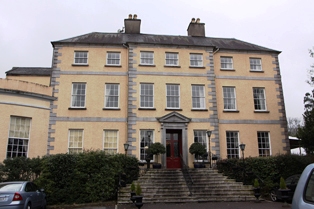
|
| Doughcloyne | Originally the home of the Ronayne family, it passed by marriage to the Sarsfields. Occupied by Dr Sarsfield in the 1770s and 1780s, by Mr Haynes in 1814, by D. Sarsfield in 1837 and by Thomas R. Sarsfield in the early 1850s, who held it in fee, value £43. In 1894 Slater notes it as the seat of Capt. T.R. Sarsfield. This house is no longer extant. | |
| Oldcourt | Oldcourt was the seat of the Goold family baronets until 1852 when it was bought by Alexander Glasgow. The sale rental of March 1852 includes a lithograph of Oldcourt. Griffith's Valuation records Glasgow holding the property in fee and the buildings were valued at £68. The Glasgows leased the house until it was bought in the early 20th century by Henry O'Shea although Alexander J. Glasgow is recorded as the occupier in 1906 when it was valued at £51. Henry O'Shea sold it to the Brothers of Charity in 1934 whose services used it as a Special Needs school. It is still extant. |
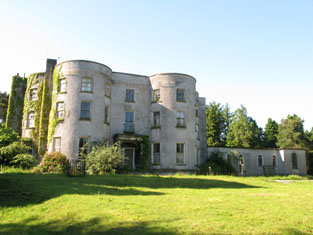
|
| Mount Desert | The home of the Dunscombe family in the 18th and 19th centuries, it was noted by Wilson as the seat of Mr. Dunscombe in 1786. The house was occupied by George Dunscombe in 1814 and by Nicholas Dunscombe in the early 1850s when it was valued at £55. Still valued at the same amount in 1906 when it was occupied by Robert Dunscombe. The house is no longer extant and the Bon Secours Health Care unit is now located at this site. |

|
| Montpellier | A house occupied by the Reverend Morgan O'Donovan in 1837 and by Morgan O'Donovan in the early 1850s. The house was held in fee by the O'Donovans and was valued at £55. There is no trace of this house now as modern development has taken place in the area. | |
| Waterfall | Occupied by Austin Esq in the 1770s and 1780s and by T. Austin in 1837. Leased by Edward Austen who held from the representatives of Viscount Midleton in the mid 19th century. The buildings were valued at £14. The house shown at this location on the 1st edition Ordnance Survey map has disappeared by the time of the publication of the 25-inch edition in the 1890s. Buildings do still exist at the site. | |
| Castle White | Occupied by Whyte Esq in the 1770s Wilson refers to this property as Rochfordstown in 1786. George M. White was the owner in 1837 and held by him in fee at the time of Griffith's Valuation when the house was valued at £35. Lucia P. Hawkes was recorded as the occupier of two mansion houses in this townland in 1906, one valued at £27 and the other at £53. Castle White is still extant. In 2023 it was offered for sale by Sothebys International. |
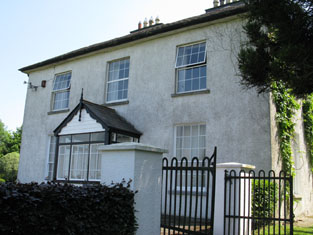
|
| Chetwynd | The Pigotts were established at Chetwynd in the early 18th century and Wilson refers to it as their seat in 1786. By the end of the century they were resident in county Laois. In 1837 J. Forrest was the proprietor of Chetwin and in the mid 19th century William Bateman occupied the house, valued at £25, which he held from John Dennis. Two houses are marked on the first Ordnance Survey map for Chetwynd. It is not clear which one was the Pigott house. | |
| Willsfort | Occupied by William Harris in 1814 and by Mrs Dowman in 1837. Francis Clancy was the occupier at the time of Griffith's Valuation holding the house valued at £26 from Jane Dowman. A house is still extant at the site. | |
| Ballincurrig | W.C. Logan occupied Ballincurrig Cottage in 1837 and William Coppinger occupied a house at Ballincurrig valued at £33 and held by him in fee at the time of Griffith's Valuation. | |
| Cleve Hill | Samuel Perrott was residing at Cleve Hill in 1837 and in the early 1850s when the house was valued at £68 and held from Alexander McCarthy. Cleve Hill a modern family mansion on 13 acres was advertised for sale in October 1873, the estate of Joseph Gadsden Nash and Arthur Power Harty, bankrupts. | |
| Clifton | John Moore Travers inhabited this house in the first half of the 19th century. At the time of Griffith's Valuation Clifton was valued at £65 and held from the Earl of Bandon. John M. Travers only child Elizabeth married in 1827 Sir William Henry St Lawrence Clarke, Baronet. Later the home of Nicholas Murphy and in the 20th century in use as a convent. | |
| Besborough | In the 1770s the residence of Allen Esq. The seat of the Pike family for most of the 19th century. Occupied by J. Spence in 1814 and by Ebenezer Pike in 1837 and in the early 1850s. He held the property from the representatives of Bousfield and the house was valued at £78. This house was used as a convent in the 20th century. http://www.askaboutireland.ie/reading-room/history-heritage/big-houses-of-ireland/bessborough-house-and-est/index.xml | |
| Hampstead | The residence of G. Britton in 1814 and of Lieutenant Boyle Hill in 1837. Occupied by John H. Bainbridge at the time of Griffith's Valuation. He held the property in fee and the house was valued at £22. The house is not labelled on the 25-inch Ordnance Survey map of the 1890s and is no longer extant. | |
| Ballygaggin | Occupied by Edmond Murphy at the time of Griffith's Valuation, valued at £30 and held from the Duke of Devonshire. | |
| Frankfield | Located on the side of what is now the Frankfield Golf Club, Frankfield House was occupied by S. Lane in 1837 and by the Very Reverend H. J. Newman in the mid 19th century. Reverend Newman held it from William Lane and the buildings were valued at £60. | |
| Lee Cottage | Marked on the first Ordnance Survey map this house was occupied by Henry O. Seward in the early 1850s when it was valued at £52 and held from the Ecclesiastical Commissioners. Now incorporated into the university. | |
| Castlemahon | Seat of the Chatterton family, occupied by Sir James Chatterton in 1814 and Sir William in 1837 and at the time of Griffith's Valuation when it was valued at £47. The property was held from the Ecclesiastical Commissioners. The building now houses a youth centre run by the Redemptorist Order. |
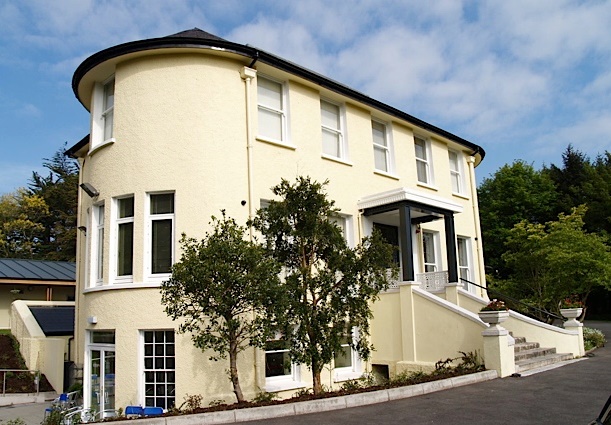
|
| Ferney | Ferney was the residence of Mrs Coote in 1814 and of J.H. Manley in 1837. Joseph Manly occupied the house valued at £68 at the time of Griffith's Valuation. He held it from Sir William Chatterton. This house is still extant. | |
| Lakeview | Occupied by Miss Allen in 1837 and by William Prittie Harris in the early 1850s when the house was valued at £28 and held from Sir William Chatterton. In the 1870s Richard Harris of Lakeview, Cork, owned 169 acres. This house no longer exists. | |
| Ringmahon Castle | The proprietor of Ring Mahon Castle in 1837 was J. Murphy. James Murphy occupied the house valued at £68 in the early 1850s and held the property from William Crawford who held from the Chattertons by lease dated 1797. This property was still in the possession of the Murphy family at the end of the 19th century. | |
| Dundanion Castle | The residence of the architect Sir Thomas Deane in 1837, valued at £78 in the early 1850s and held from Richard Sampson. Sold by Sir Thomas to William Wise in 1860 and by Wise to William Thornton in 1868. A residence is still extant at this site. | |
| Garrane | In the early 1850s Francis Hennis occupied a house valued at £30 from William Howe Hennis. A building still exists at this site. | |
| Grange | H. Conron occupied Grange in 1837 and at the time of Griffith's Valuation when the buildings were valued at £40 and held from J.D.C. Beamish. Hatton Condon was still living at Grange in the 1870s. In 1894 Slater records Grange as the seat of E.R. Conron. This house no longer exists. | |
| Lehenaghbeg | A house valued at £14 in the mid 19th century and held by Edward Casey from James H. S. Barry. Edward Casey was the owner of 121 acres at Lehenaghbeg in the 1870s. | |
| Lehenagh | Occupied by T. Curtis in 1837. By the early 1850s Mary Curtis was resident holding the house valued at £28 from the Reverend Edward H. Newinham. | |
| Lehenagh House | A home of a member of the Newingham family in 1814 and of Charles Mathew in the mid 19th century.James Mathews of Lehenagh owned 107 acres in the 1870s. This house no longer exists. | |
| Ashton | A house occupied by John Cotter from at least 1814 until his death in 1864 and by Mrs Catherine Cotter until at least 1871. It is not clear if John Cotter was a member of the Cotter family, baronets. The house is now part of the Ashton School complex. | |
| Charlemont House | Charlemont House was leased by Charles Evanson from Nicholas G. Allen at the time of Griffith's Valuation, when it was valued at £20. It was included in the sale of Evanson property in the Landed Estates Court in November 1862. It is still extant. | |
| Woodhill | Originally this property belonged to the Dennis family. Following the marriage of Elizabeth Dennis to Cooper Penrose, a Quaker, of Waterford, it passed into the possession of the Penrose family, who enlarged the house. Another Cooper Penrose was the occupant in 1814 and in the mid 19th century holding the property from James Murphy. The buildings were valued at £100. The house was demolished circa 1980s. | |
| Parkgarriff | This house was the home of at least two generations of David Cagneys in the 19th century. The house was valued at £40 at the time of Griffith's Valuation and held by David Cagney from Lord de Vesci. The Cagneys were still resident in the 1870s. The house no longer exists and the site is located on the edge of the Monkstown Golf Club. | |
| Wilton | In 1786 Wilson refers to "Willtown" as the seat of Mr. Izod. Charles H. Leslie occupied Wilton in 1814 and in 1837. By the mid 19th century Matthew Leslie was resident, holding the house valued at £55 from John Craig and H. Mitchell. A college is now located at this site. | |
| Ballynora | A house valued at £14 and held by Thomas Magner in the mid 19th century from the representatives of John McSweeny. | |
| Shanakiel | Daniel Leahy is recorded as the occupier of Shanakiel House in the first half of the 19th century. The house was valued at £85 in the early 1850s and held from the Earl of Cork and Orrery. This house no longer exists and its site is located in the grounds of a hospital. | |
| Maglin | A house valued at £15 and held by James Barry [Berry] from John Popham and others at the time of Griffith's Valuation. Buildings are still extant at this location. | |
| Spud Villa | This house is marked on the first edition Ordnance survey map. Anne and Jane Wise occupied a house in the townland of Mount Desert valued at £38 and held from Thomas Wise in the mid 19th century. | |
| Mounthovel House | In 1786 Wilson refers to Mounthovel as the seat of Mr. Farmer. At the time of Griffith's Valuation, Mout Hovel House was occupied by Edward Newenham leasing from the Atkins estate and valued at £8. It is no longer extant and the area is now occupied by modern housing. | |
| Hop Island | At the time of Griffith's Valuation, Osborne Edwards was leasing this property from the Chatterton estate when it was valued at £16. It is labelled Hop Island on both the 1st and 25-inch edition Ordnance Survey maps. This may be the property referred to by Wilson as Red Island, the seat of Rev. Mr. Saunders, in 1786. A house is still extant at the site. |

